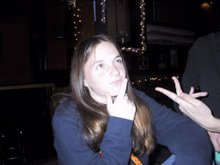For a poetry unit I'm doing for class, I'm trying to introduce poetry that they are familiar with. My aim for the unit is to make them enjoy poetry and see that it is not all boring and terrible. So, in order to do so, I am introducing the unit with Dr. Seuss.
The library had this humongous book of collections of his children's book along with his illustrations and essays from devoted fans. I am getting a little into it though, continuously researching his life because I find it borderline fascinating.
So let me share with you.
Dr. Seuss, whose last name was actually not Seuss, nor was he a doctor, was born in 1904 and went through Prohibition during college. Can you imagine? He was an editor for a newspaper at his college, and when throwing a party when it was literally banned in the country, was caught. He was expelled from participating in extracurricular activities. In order to continue his passion to write and draw, he needed to use a pen name. He chose his mother's maiden name, Seuss, and used Dr. to sort of mock the fact that he dropped out of his doctorate program in literature to write and illustrate.
Theodor Geisel was his real name. During WWII, Seuss began to draw a series of political cartoons, perhaps a fact that not many are aware of. Here is one below which pictures Japanese Americans entering California. His cartoons varied from Prohibition, pro/cons of Roosevelt, the Soviet Union, Congress, Communists, Nazis, and WWII overall.
Here is a political cartoon or two depicting Hitler:
After WWII, Dr. Seuss began to write his famous children's books. Many of his popular books were created during the 1950s and 1960s. Before writing Green Eggs and Ham, supposedly, Dr. Seuss was challenged that he could not write a story in 50 words. Seuss won the bet by writing Green Eggs and Ham. Additionally, a publisher gave Dr. Seuss a list of 400 words he thought were important for children to know as they develop as readers. That list was cut down to 220, in which Seuss used all the words, compiling the famous children's book The Cat in the Hat.
Dr. Seuss spent much time concoting the ideas behind each book. Each book generated a larger message that he wanted to spread to others. He even identified with certain characters he created. He writes that he identified mostly with the Cat in the Hat, and through a political cartoon, he illustrates his identification with the Grinch. His inspiration for writing The Grinch came not only out of consumerism during Christmas, but his own agitation towards Christmas, almost being a slight Grinch himself. In the book, he draws a cartoon of himself looking in the mirror, and in return reflects the Grinch. Quite interesting.
Colleagues of Dr. Seuss wrote an introduction to the book. They commented that Dr. Seuss would spend hours, DAYS going over each stanza and phrase until the book used the perfect words just right. He wanted such an easy-flowing rhyme with an overarching message. Obviously, his work paid off, for he is one of the most recognized children's authors of all time.
Although, he never had any children of his own. When asked by a children trick-or-treating at his house why he never had any, he responded that he didn't think he would be a good father (Wikiepdia). Dr. Seuss eventually died in 1991 after suffering an illness.
Famous Dr. Seuss books:
Horton Hatches the Egg (1940)
The Cat in the Hat (1957)
How the Grinch Stole Christmas (1957)
Yertle the Turtle (1958)
Green Eggs and Ham (1960)
One Fish Two Fish Red Fish Blue Fish (1960)
Dr. Seuss's ABC (1960)
Fox in Sox (1965)
My Book about ME (1969)
Mr. Brown Can Moo, Can You? (1970)
There's a Wocket in My Pocket! (1974)
Oh, The Things You Can Think! (1975)
Oh, The Places You'll Go! (1990)
What is your favorite Dr. Seuss book? Why?
Do you think recent movie adaptations do the books justice?

1 comment:
I believe he'd be proud, and happy with the movie. Whether or not they do him justice is another question. Can you really do justice to genius?
Post a Comment